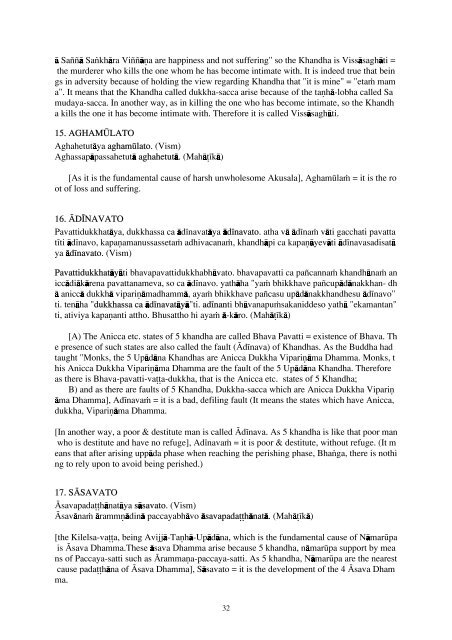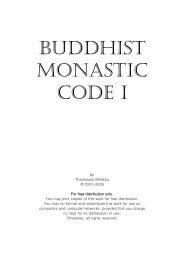Vipassana Kammatthana.pdf
Vipassana Kammatthana.pdf
Vipassana Kammatthana.pdf
You also want an ePaper? Increase the reach of your titles
YUMPU automatically turns print PDFs into web optimized ePapers that Google loves.
å Saññå Sa∫khåra Viññåˆa are happiness and not suffering" so the Khandha is Vissåsaghåti =<br />
the murderer who kills the one whom he has become intimate with. It is indeed true that bein<br />
gs in adversity because of holding the view regarding Khandha that "it is mine" = "eta◊ mam<br />
a". It means that the Khandha called dukkha-sacca arise because of the taˆhå-lobha called Sa<br />
mudaya-sacca. In another way, as in killing the one who has become intimate, so the Khandh<br />
a kills the one it has become intimate with. Therefore it is called Vissåsaghåti.<br />
15. AGHAMÚLATO<br />
Aghahetutåya aghamËlato. (Vism)<br />
Aghassapåpassahetutå aghahetutå. (Mahå ¥kå)<br />
[As it is the fundamental cause of harsh unwholesome Akusala], AghamËla◊ = it is the ro<br />
ot of loss and suffering.<br />
16. ÓDÁNAVATO<br />
Pavattidukkhatåya, dukkhassa ca åd¥navatåya åd¥navato. atha vå åd¥na◊ våti gacchati pavatta<br />
t¥ti åd¥navo, kapaˆamanussasseta◊ adhivacana◊, khandhåpi ca kapaˆåyevåti åd¥navasadisatå<br />
ya åd¥navato. (Vism)<br />
Pavattidukkhatåyåti bhavapavattidukkhabhåvato. bhavapavatti ca pañcanna◊ khandhåna◊ an<br />
iccådiåkårena pavattanameva, so ca åd¥navo. yathåha "ya◊ bhikkhave pañcupådånakkhan- dh<br />
å aniccå dukkhå vipariˆåmadhammå, aya◊ bhikkhave pañcasu upådånakkhandhesu åd¥navo"<br />
ti. tenåha "dukkhassa ca åd¥navatåyå"ti. ad¥nanti bhåvanapu◊sakaniddeso yathå "ekamantan"<br />
ti, ativiya kapaˆanti attho. Bhusattho hi aya◊ å-kåro. (Mahå ¥kå)<br />
[A) The Anicca etc. states of 5 khandha are called Bhava Pavatti = existence of Bhava. Th<br />
e presence of such states are also called the fault (Ód¥nava) of Khandhas. As the Buddha had<br />
taught "Monks, the 5 Upådåna Khandhas are Anicca Dukkha Vipariˆåma Dhamma. Monks, t<br />
his Anicca Dukkha Vipariˆåma Dhamma are the fault of the 5 Upådåna Khandha. Therefore<br />
as there is Bhava-pavatti-va a-dukkha, that is the Anicca etc. states of 5 Khandha;<br />
B) and as there are faults of 5 Khandha, Dukkha-sacca which are Anicca Dukkha Vipariˆ<br />
åma Dhamma], Ad¥nava◊ = it is a bad, defiling fault (It means the states which have Anicca,<br />
dukkha, Vipariˆåma Dhamma.<br />
[In another way, a poor & destitute man is called Ód¥nava. As 5 khandha is like that poor man<br />
who is destitute and have no refuge], Ad¥nava◊ = it is poor & destitute, without refuge. (It m<br />
eans that after arising uppåda phase when reaching the perishing phase, Bha∫ga, there is nothi<br />
ng to rely upon to avoid being perished.)<br />
17. SÓSAVATO<br />
Ósavapada hånatåya såsavato. (Vism)<br />
Ósavåna◊ årammˆådinå paccayabhåvo åsavapada hånatå. (Mahå ¥kå)<br />
[the Kilelsa-va a, being Avijjå-Taˆhå-Upådåna, which is the fundamental cause of NåmarËpa<br />
is Ósava Dhamma.These åsava Dhamma arise because 5 khandha, nåmarËpa support by mea<br />
ns of Paccaya-satti such as Órammaˆa-paccaya-satti. As 5 khandha, NåmarËpa are the nearest<br />
cause pada håna of Ósava Dhamma], Såsavato = it is the development of the 4 Ósava Dham<br />
ma.<br />
32






